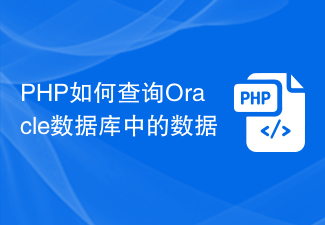How to query data in Oracle database with PHP
With the advent of the Internet era, the development of websites and applications is becoming more and more common. As a key technology for data storage and management, database has also become one of the necessary tools for developers. Among them, Oracle database, as a powerful, stable and reliable relational database management system, has been widely used in enterprise-level applications. When developing a website or application, how to use PHP to query the Oracle database is a very important issue.
Before we begin, we need to ensure that the appropriate software environment is installed locally. The Oracle client software needs to be installed first, and then the Oracle extension for PHP (OCI8) can communicate with the Oracle database. After ensuring that the corresponding software is installed, we can start the following operations.
Step 1: Connect to Oracle database
First, we need to establish a connection with the Oracle database through PHP code. Use PHP's oci_connect() function to connect to the database. The specific code is as follows:
<?php
$host = "localhost"; //Oracle主机地址
$port = "1521"; //Oracle监听端口
$sid = "ORCL"; //Oracle服务名或SID
$username = "your_username"; //Oracle数据库用户名
$password = "your_password"; //Oracle数据库密码
// 使用oci_connect函数连接Oracle数据库
$connect = oci_connect($username, $password, "$host:$port/$sid");
// 判断是否连接成功
if (!$connect) {
$e = oci_error();
trigger_error(htmlentities($e['message'], ENT_QUOTES), E_USER_ERROR);
}
else {
echo "连接Oracle数据库成功!";
}
?>Step 2: Query Oracle database data
After the connection is successful, we can query the Oracle database through PHP code Data. Use the oci_parse() function to parse the SQL query statement, and then use the oci_execute() function to execute the SQL statement. The specific code is as follows:
<?php
// 连接Oracle数据库的代码省略
// SQL查询语句
$sql = "SELECT * FROM table_name";
// 解析SQL查询语句
$statement = oci_parse($connect, $sql);
// 执行SQL查询语句
$result = oci_execute($statement);
// 判断是否查询成功
if (!$result) {
$e = oci_error($statement);
trigger_error(htmlentities($e['message'], ENT_QUOTES), E_USER_ERROR);
}
else {
// 循环打印查询结果
while ($row = oci_fetch_array($statement, OCI_ASSOC+OCI_RETURN_NULLS)) {
foreach ($row as $item) {
echo $item." ";
}
echo "<br>";
}
}
?>In the above code, we use SELECT * FROM table_name to query all the data in the table, and use the oci_fetch_array() function to obtain the data of each row from the query results. Then use a loop to traverse the $row array and print out the data of each row. It should be noted that the two parameters OCI_ASSOC OCI_RETURN_NULLS are used to set the format of the data returned by the oci_fetch_array() function.
Step 3: Close the database connection
After completing the database query, we need to manually close the connection with the Oracle database to avoid occupying too many system resources. Use the oci_close() function to close the connection. The specific code is as follows:
<?php
// 查询Oracle数据库的代码省略
// 关闭与Oracle数据库的连接
oci_close($connect);
echo "关闭Oracle数据库连接成功!";
?>At this point, we have completed the entire process of using PHP to query data in the Oracle database. Through the above steps, we can easily connect to the Oracle database and query the data in it. Of course, according to actual needs, we can also use the WHERE clause to add query conditions, and the ORDER BY clause to sort the query results, etc.
To summarize, using PHP to query data in an Oracle database is not complicated. The key is to first ensure that the Oracle client software is installed correctly and the PHP Oracle extension is configured. Then connect to the database through the oci_connect() function, use the oci_parse() function to parse the SQL query statement, use the oci_execute() function to execute the query statement, use the oci_fetch_array() function to obtain the query results, and print out the data of each row through a loop. Finally, use the oci_close() function to close the database connection and release system resources.
Through the above code examples, I believe readers have understood how to use PHP to query data in the Oracle database. It is hoped that readers can flexibly use this knowledge to develop more powerful and efficient websites and applications based on their actual situations.
The above is the detailed content of How to query data in Oracle database with PHP. For more information, please follow other related articles on the PHP Chinese website!
 如何查证JBL耳机的真假信息Dec 29, 2023 pm 10:54 PM
如何查证JBL耳机的真假信息Dec 29, 2023 pm 10:54 PMjbl耳机是很多听音乐用户的首选,好评如潮,但是对于假货大家还是非常的害怕的,那么jbl耳机怎么查询真伪来避免这个问题呢?下面就看看怎么查询吧。jbl耳机怎么查询真伪:1、首先进入“中国商品信息验证中心”。2、然后输入查询码,即可查看是否正确从而判断是不是真货。3、也可以去通过耳机声音的清晰度来进行分辨。正牌的耳机声音是非常的清晰的,音质也不会出现改变。假牌的耳机声音会有很多的掺杂,音质也是特别的差。4、大家可以将自己的耳机声音开到最大,看看是不是很和谐,真耳机声音都是一样的。但是假耳机的声音开
 steam怎么查询账号idFeb 07, 2024 pm 12:09 PM
steam怎么查询账号idFeb 07, 2024 pm 12:09 PMSteam是一个整合游戏下载平台,玩家可以在该平台上购买正版的游戏,也可以跟其他玩家进行沟通讨论交流。有小伙伴知道steam怎么查询账号id吗,下面小编就给大家详细介绍一下steam查询账号id的方法,有需要的小伙伴可以来看一看。查询方法:1、双击打开软件,点击上方菜单栏中的"查看"。2、然后点击下方选项列表中的"设置"。3、在打开的窗口界面中,点击左侧栏中的"账户"选项,然后找到右侧中的"账户名称"即可查询到账号id。
 买过比特币怎么查询,怎么看自己买没买过比特币Feb 04, 2024 am 08:09 AM
买过比特币怎么查询,怎么看自己买没买过比特币Feb 04, 2024 am 08:09 AM现在怎么买比特币的800字公众号文章随着比特币的价格飙升,越来越多的人开始关注比特币,也有越来越多的人想要投资比特币。但是,投资比特币也是有风险的,所以在投资之前,需要了解相关知识,并做好风险控制。那么现在怎么买比特币呢?首先,为了投资比特币,您需要准备一个比特币钱包。比特币钱包是一种软件,用于存储、发送和接收比特币资金。根据您的需求,有多种类型的比特币钱包可供选择,例如硬件钱包、软件钱包和网络钱包。每种钱包都有其独特的特点,您可以根据自己的需求选择适合自己的。其次,你需要选择一个可靠的比特币交
 PHP如何查询Oracle数据库中的数据Jul 13, 2023 pm 07:34 PM
PHP如何查询Oracle数据库中的数据Jul 13, 2023 pm 07:34 PMPHP如何查询Oracle数据库中的数据随着互联网时代的到来,网站和应用程序的开发越来越普遍。而数据库作为数据存储和管理的关键技术,也成为了开发者们必备的工具之一。其中,Oracle数据库作为一款功能强大、稳定可靠的关系型数据库管理系统,在企业级应用中得到了广泛应用。而在开发网站或应用程序时,如何使用PHP进行Oracle数据库的查询是一个非常重要的问题。在
 PHP表单处理:表单数据查询与筛选Aug 07, 2023 pm 06:17 PM
PHP表单处理:表单数据查询与筛选Aug 07, 2023 pm 06:17 PMPHP表单处理:表单数据查询与筛选引言在Web开发中,表单是一种重要的交互方式,用户可以通过表单向服务器提交数据并进行进一步的处理。本文将介绍如何使用PHP处理表单数据的查询与筛选功能。表单的设计与提交首先,我们需要设计一个包含查询与筛选功能的表单。常见的表单元素包括输入框、下拉列表、单选框、复选框等,根据具体需求进行设计。用户在提交表单时,会将数据以POS
 查询从节点X开始,距离最多为D的子树中的最小权重Aug 25, 2023 am 11:25 AM
查询从节点X开始,距离最多为D的子树中的最小权重Aug 25, 2023 am 11:25 AM在进行计算机编程时,有时需要求出源自特定节点的子树的最小权重,条件是该子树不能包含距离指定节点超过D个单位的节点。这个问题出现在各个领域和应用中,包括图论、基于树的算法和网络优化。子树是较大树结构的子集,指定的节点作为子树的根节点。子树包含根节点的所有后代及其连接边。节点的权重是指分配给该节点的特定值,可以表示其重要性、重要性或其他相关指标。在这个问题中,目标是找到子树中所有节点中的最小权重,同时将子树限制在距离根节点最多D个单位的节点。在下面的文章中,我们将深入研究从子树中挖掘最小权重的复杂性
 高德地图API文档解读:Java代码实现公交车在线运行状态查询Jul 29, 2023 pm 10:45 PM
高德地图API文档解读:Java代码实现公交车在线运行状态查询Jul 29, 2023 pm 10:45 PM高德地图API文档解读:Java代码实现公交车在线运行状态查询导语:随着城市的发展,公共交通的重要性越来越凸显出来。人们对公交车的运行状态有着强烈的需求,例如实时到站时间、拥挤程度等信息。高德地图提供了强大的API以满足这方面的需求。本文将解读高德地图API文档,使用Java代码实现公交车在线运行状态查询,并提供代码示例。API概述高德地图API提供了丰富的
 如何通过优化查询中的LIKE操作来提高MySQL性能May 11, 2023 am 08:11 AM
如何通过优化查询中的LIKE操作来提高MySQL性能May 11, 2023 am 08:11 AMMySQL是目前最流行的关系型数据库之一,但是在处理大量数据时,MySQL的性能可能会受到影响。其中,一种常见的性能瓶颈是查询中的LIKE操作。在MySQL中,LIKE操作是用来模糊匹配字符串的,它可以在查询数据表时用来查找包含指定字符或者模式的数据记录。但是,在大型数据表中,如果使用LIKE操作,它会对数据库的性能造成影响。为了解决这个问题,我们可


Hot AI Tools

Undresser.AI Undress
AI-powered app for creating realistic nude photos

AI Clothes Remover
Online AI tool for removing clothes from photos.

Undress AI Tool
Undress images for free

Clothoff.io
AI clothes remover

AI Hentai Generator
Generate AI Hentai for free.

Hot Article

Hot Tools

EditPlus Chinese cracked version
Small size, syntax highlighting, does not support code prompt function

Dreamweaver CS6
Visual web development tools

WebStorm Mac version
Useful JavaScript development tools

SublimeText3 Mac version
God-level code editing software (SublimeText3)

DVWA
Damn Vulnerable Web App (DVWA) is a PHP/MySQL web application that is very vulnerable. Its main goals are to be an aid for security professionals to test their skills and tools in a legal environment, to help web developers better understand the process of securing web applications, and to help teachers/students teach/learn in a classroom environment Web application security. The goal of DVWA is to practice some of the most common web vulnerabilities through a simple and straightforward interface, with varying degrees of difficulty. Please note that this software






